Figure 1.
Animals pre-exposed to nicotine during periadolescence (right panel) and postadolescence (left panel) differed during acquisition of nicotine SA (age × treatment × day interaction, F(14,350) = 1.80; p < 0.05). Within the periadolescent group, nicotine-pretreated animals showed more nose pokes in the active device delivering nicotine (0.04 mg/kg per infusion) than did vehicle-pretreated controls, and this during the entire acquisition period (treatment effect, F(1,11) = 4.64; p < 0.05). Conversely, within the postadolescent group, nicotine-pretreated animals showed more active nose pokes than vehicle-pretreated controls, only during the FR1 period (treatment × day × hole interaction, F(14,196) = 2.03; p < 0.05). The two groups did not differ anymore when the FR requirement was increased over days. The two vehicle-pretreated groups did not differ at any time (age effect, F(1,12) = 2.28; p = 0.6). Responses in the inactive device had no schedule consequences and were used as a control of SA. The two age groups (periadolescent and postadolescent) did not differ for the number of inactive responses. Similarly, in both age groups, vehicle-treated and nicotine-pretreated animals did not differ for inactive responses. FR indicates the number of active responses necessary to obtain one infusion of nicotine. *p < 0.05 in comparison with corresponding vehicle-pretreated animals.

